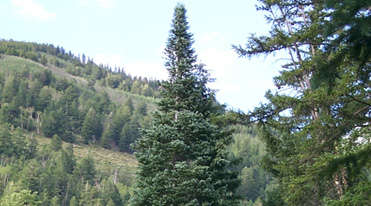Picea pungens
 One of America's favorite evergreens, this tree has sweet smelling, prickly blue-green needles. It has a broad spread and grows to about 120'. Though indigenous to the West, it adapts well to all climates anywhere that evening temperatures dip below 50° several months per year.
One of America's favorite evergreens, this tree has sweet smelling, prickly blue-green needles. It has a broad spread and grows to about 120'. Though indigenous to the West, it adapts well to all climates anywhere that evening temperatures dip below 50° several months per year.
The Blue Spruce is one of the most admired and widely known of all North American evergreens. A mountain tree, it has been successfully planted over most of the USA and throughout Europe. It is also known as the Silver or Colorado Spruce and is part of the Pine family. A straight growing tree with horizontal branches, its limbs droop slightly to form a clustered appearance. It can grow to 115' in height and its needles are blue-green, short (1/2- 1 1/2"), slightly curved, and very stiff and pointy. The scientific name pungens comes from the Latin word meaning, "to prick". The needles give off a pleasant, resinous smell when rubbed between the fingers.
 The papery cones of the Blue Spruce are 3-4" long, a light chestnut color, and are the female "flowers" of the tree. In the Spring, the scales of the cone expand to catch wind-blown pollen from the male flowers, which are on the same tree but different branches. Soon after being fertilized, the cones turn down and become pendulous.
The papery cones of the Blue Spruce are 3-4" long, a light chestnut color, and are the female "flowers" of the tree. In the Spring, the scales of the cone expand to catch wind-blown pollen from the male flowers, which are on the same tree but different branches. Soon after being fertilized, the cones turn down and become pendulous.
The Blue Spruce is America’s favorite Christmas tree and is used extensively in landscaping. It is also planted in reforestation efforts and shelterbelts. During winter, varied birds and wildlife feed from its needles, twigs and seeds and nest in its branches.
Natural Habitat of Blue Spruce: Rocky Mountains & the Southwest often near streams. Best in fertile soil with abundant moisture. Once established can withstand drought and temperature extremes.
